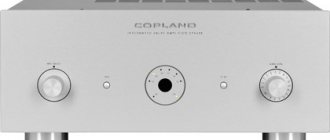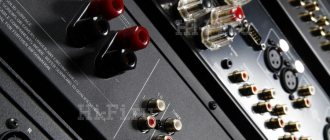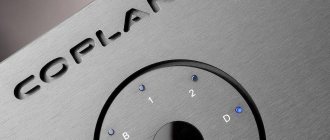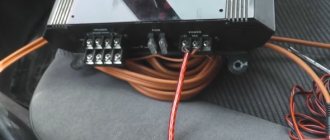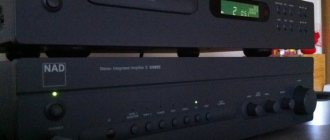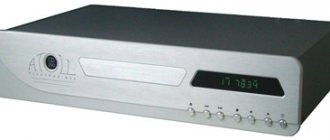Musical Fidelity M6i vs Musical Fidelity M5si
For Alex. (with all due respect to the latter):
Musical Fidelity guarantees the best sound results when connected via a balanced input. Source connection in M5i is provided only via unbalanced inputs. Unlike the more expensive M6i, which has balanced inputs as a priority, there is no such option here. Connecting to a regular linear input is characterized by a slight decrease in gain (compared to the M6i via the balanced input - with the volume knob position being the same on the two devices). If you set the volume knobs on the devices so that the volume is the same, then from both of them you get an almost identical open sound with the same strong dynamic temperament.
Strict tonal balance with cool shades is inherent in the entire Fidelity musical line, and not just these two integrals. In the upper middle, the fifth and sixth equally appear to have some dryness, but it is very slight. We find more differences between them, which can be seen in the alignment of the virtual scene. The scale remains, but localization on the flanks (especially when playing music with a dense spectrum) is already noticeably different in clarity and stability, with a noticeable advantage ONLY in the balanced connection of the more expensive M6i device.
The bass of both devices is powerful and full-bodied - there are no complaints about it at all. And the lower middle pleases with its harmony. Here, the Musical Fidelity M5i integrated amplifier sounds completely without falsehood, with natural and fast dynamics. In the mid-frequency range, a slight hardware tint of digital origin appears, and detail deteriorates slightly for audiophile ears. The upper register is at the midrange level, there is no obvious metallic coloring, everything is very airy and, in principle, “audible”. In space, images with a low-mid-frequency spectrum and concentrated closer to the center emerge steadily and clearly. They create the illusion of a full-scale scene with quite a lot of depth.
For some reason, the Musical Fidelity engineers did not bother to equalize the levels across different inputs, and switching to a digital USB input leads to an additional attenuation of the volume. Although this drawback of both devices does not affect the sound quality at all.
As for the overall impression of the sound, both amplifiers, either with a 200-watt output or with a 150-watt output, form a powerful and geometrically correct sound stage. All plans are easy to read, in place, and apparent sound sources are not exaggerated or reduced. The devices do not add any special touches, and correctly convey the harmonic flavor of all instruments without exception. The bass is almost perfect, there’s nothing to say here... It’s felt that the engineers did not skimp on the energy of the power supplies and the real power just rushes... the bass is inextricably linked with the mid frequencies, the music plays seamlessly on any genre. The amplifiers dampen the acoustics well and the speakers do not wobble at all. The low end is clear, fast and very powerful. The upper mids and treble are very neutral. The cool tones in the sound can be attributed to the English breed of Musical Fidelity with their foggy and rainy days). But you don’t feel an ounce of transistor coloring; it feels like it’s being played by a tube device, or, well, almost a tube device. All the details in this integrated circuit, as on a tube device, are reproduced in the smallest detail. The Musical Fidelity M5si integrated amplifier produces a lot of musical information; you quickly get used to its balanced and powerful sound, despite the initial apparent coldness.
And the most important thing is that I consider selling 5si in order to buy 6si complete idiocy, especially for bookshelf speakers, it would be nice if there were heavy floor-standing acoustics or switching to only a balanced connection where an increase is possible in the localization of the sound stage... It’s better to buy a more expensive DAC, or even better, a separate preamp and amplifier power... In short, my Emotiva is 100% cooler...
CDs have a future. Review of the Musical Fidelity M6CD CD player
We start testing with a CD of Vivaldi's "The Four Seasons" - and Musical Fidelity is revealed in all its glory. Its sound is equal parts powerful and delicate; The sound stage is huge and well-developed. We especially liked the surprisingly transparent midrange and natural reproduction of changes in music saturation.
It is also worth noting the high refinement: even on a good system, violins sometimes sound too harsh, but the M6CD reproduces them with impeccable accuracy without flattening the sound. The spacious sound stage allows all instruments to be positioned at ease, and the sound does not seem overloaded.
Powerful, deep bass
The tonal balance of Musical Fidelity is slightly biased towards deep and powerful bass. However, the company's developers know their stuff: the sound does not seem heavy, the rich low frequencies simply add warmth and weight to it.
Daft Punk's "Get Lucky" sounds powerful and nuanced. The rhythmicity cannot be called completely flawless, however, the combination of expressive dynamics and high detail creates an exciting sound. Sometimes it happens that material of less than ideal quality is still very pleasant to listen to, and this is just such a case.
To stay connected
1. Analogue outputs
Like most models in this category, the M6CD is equipped with analog outputs - balanced XLR and unbalanced RCA.
2. Digital inputs
Unlike most CD players, the M6CD doesn't ignore the fact that many people store music on their computer. Digital inputs allow you to improve the quality of its sound compared to what a PC provides. The USB port, the most obvious connection option, is the weakest of the three inputs.
The sound from the digital inputs leaves a mixed impression: the scale and dynamics inherent in CD playback become somewhat lower, while the level of sophistication remains the same high. The signal from the USB port is reproduced worse than others; Optical and coaxial inputs provide good results for a wide range of music - from Kate Bush's 50 Words for Snow in 24/96 format to By the Way by the Red Hot Chili Peppers.
Apart from comments on sound quality, we have no complaints about this player; It has a solid body with excellent finishing and a strict front panel. It’s just that it’s not easy to reach the transport control buttons located under the disc tray when it’s open.
The most disappointing thing is the display: it has a small viewing angle and poor text scrolling quality. At this price it could be better.
The list of connections includes balanced and unbalanced analog, as well as digital optical and coaxial outputs and the already mentioned three inputs.
The M6CD is quite good; Perhaps its sound quality is not ideal, but many will like it. We're a little disappointed with the playback from digital inputs compared to CDs, but the fact that they're there is respectable. All owners of large CD collections have a reason to get to know this player better.
Price: $3250
Grade: 4
PROS: Transparent and well-developed midrange; smooth dynamics; powerful low frequencies; digital inputs
CONS: Not the standard for accuracy; The USB port only supports 24bit/48kHz; uncomfortable display
VERDICT: M6CD is quite good; its powerful and sophisticated sound will appeal to many
Possible options
Roksan Caspian M2 (CD player) $3200
This player surpasses the M6CD in rhythmic precision and bass balance
Features of Musical Fidelity M6Si
While the M6si isn't a monster by today's standards, many will still consider it a large integrated amplifier with dimensions of 440 x 125 x 400mm (h/h/d) and a weight of 16.6kg. The M6si really is a lot of amplifier, delivering 220 watts per channel into 8 ohms. In addition to the phono and USB inputs, there are four line-level RCA inputs and a balanced XLR input, with one of the RCA inputs configurable for control from an external AV device.
The phono input has a nominal sensitivity of 3 mV nominal (MM), 0.4 mV nominal (MC), and the input impedance is fixed at 47 kOhm (both MM and MC). The input for the DAC is USB type B, passing data with a resolution of up to 24 bits / 96 kHz. An SPDIF RCA or BNC input would be nice, but not all.
The fit and finish is excellent, and all the knobs and buttons (which are a little small if you have thick fingers) feel solid to the touch. The bezel is beautiful in 'matte silver', but the M6si also comes in matte black if you prefer. Large silver volume control knob in the center, located at the dead center of the amplifier. Even though it is motorized and can be controlled using the included remote control. In terms of sonic personality, the M6si feels solid and authoritative, but with an almost effortless, calm demeanor, preferring a slightly more laid-back presentation than any notion of 'strictly neutral'. It all starts with a solid foundation in the low frequencies.
Musical Fidelity M6DAC - Exceptional DAC with Luxurious Sound
Three thousand dollars is a hefty sum for a digital-to-analog converter; however, Musical Fidelity's M6 DAC is not just any DAC. The company's pedigree in this market segment is enviable; it was one of the pioneers of component DACs back in the 80s, when they were used only to improve the sound of a few CD players. Today, the main function of a device of this kind is to convert audio signals from a computer.
Profile
Price $3200
* *****
What's special about them?
An audiophile-grade DAC with an asynchronous USB port, aptX Bluetooth support and multiple connections is definitely worth a look
. Tempting?
Full-scale equipment coupled with the enviable reputation of Musical Fidelity is a very interesting combination
*Approximate price
The M6 DAC looks like a top-class device in all respects. It is distinguished by its generous dimensions, as well as excellent workmanship and finishing in both color options - black (pictured) and silver.
Taking a look at the back panel, you will be inspired to respect the solidity of Musical Fidelity. In addition to the USB port, the DAC is equipped with coaxial and optical inputs, supporting formats up to 24-bit/96 kHz (optical) and 24/192 (coaxial), as well as the less common AES/EBU.
All of these inputs on the M6 DAC correspond to similar digital outputs, which are useful for recording or further signal processing.
And the availability of AptX-compatible Bluetooth connectivity sets the M6 DAC apart from its competitors.
The DAC kit includes a small external Bluetooth antenna; it provides more reliable reception than the built-in one. The cable is quite short, but this did not cause problems when working via Bluetooth.
The controls on the front panel are conveniently located and look impressive; however, the display is too small and difficult to read from a distance.
Unlike many other DACs, this device allows you to change the levels of analog signals at the outputs. By aligning them for different sources, you will be spared the need to adjust the volume when switching, for example, from a turntable to a DAC. We feel like Musical Fidelity misses an opportunity: with just a little more range, the M6 DAC could be used as a digital preamp, powered by a power amp or a pair of powered speakers.
Unbalanced inputs are better
The quality of his work is impressive. Usually, when we have balanced and unbalanced inputs, we prefer the former, but not in this case. Balanced connection, as you would expect, makes the sound bolder and more convincing, but the low frequencies are a bit ponderous, and the frequency ranges lack coherence.
When connected unbalanced, our reference Bryston BP26/4BSST2/ATC SCM50 system sounds more balanced and exciting.
You can also choose between steep and shallow filter modes.
| 1 Digital inputs The M6 DAC is equipped with an AES/EBU digital input that accepts formats up to 24-bit/192 kHz. It is not often found in household components; but Musical Fidelity saw fit to increase the compatibility of this DAC. | 2 USB port An asynchronous USB port with support for formats up to 24-bit/192 kHz allows the M6 DAC to control the timing of the data stream rather than the computer's clock generator. This improves quality. | 3 Switching Analog Outputs A small switch on the rear panel allows you to set the output level to the standard 2.2V unbalanced and 4.4V balanced outputs, or change it by ±10dB. |
DIGITAL LANGUAGE
Type
DAC
Integrated
No
Transport
No
Outputs
Coaxial digital, optical digital, XLR, RCA
Inputs
Coaxial digital, optical digital, AES/EBU, USB
Finish options
2
Dimensions (HxWxD)
10x44x38 cm
The presence of Bluetooth allows you to use the DAC with smartphones and tablets; this will be useful to many
An enviable heritage, a wide range of connections and high equipment indicate a serious approach to business
The difference is not too great, and preference is determined mainly by the tastes of the listener, as well as taking into account other components of the system; we preferred the flat option.
We were curious how Bluetooth would perform. Files of most formats are reproduced quite well when using it, but even in the case of the aptX protocol this is the most inferior connection - although even an acceptable result can be squeezed out of it. Do not forget that the presence of Bluetooth allows you to use the DAC with smartphones and tablets; this will be useful to many. Yet any other type of connection will allow Musical Fidelity to more fully present the range of its talents.
Snowflake
Kate Bush in 24-bit/96kHz impresses with mid-range quality; the sound in it is very smooth, expressive and full-blooded, and high detail allows you to convey all the nuances of Kate’s voice.
Boom Boom
John Lee Hooker from the CD is also performed superbly; M6 infects the listener with the energy and drive of the song. Models like the award-winning $1,600 NAD M51 DAC provide greater rhythmic precision, but the Musical Fidelity is also a joy to listen to.
At the same time, the M6 DAC surpasses its competitor from NAD in terms of scale and convincing sound. This impression is further enhanced by the enormous dynamic scope and energetic, albeit somewhat emphasized low frequencies. Fortunately, the bass, although slightly brought to the fore, turns out to be agile and melodic.
Lots of competitors
The main problem with the M6 is that there are many strong competitors in the same price category. The already mentioned NAD DAC sounds no worse, but costs half as much. And if you expand the price range a little, you have to reckon with the Naim DAC for $4200. It is somewhat inferior to the Musical Fidelity in terms of equipment, but it makes up for the lag with a more straightforward sound and the ability to improve quality when replacing the power supply.
What's left for the M6 DAC?
In the end, even such a talented DAC cannot be considered an absolute success. If it had boasted a little more rhythmic precision and transparency, it would have received top marks. But in this form and in the presence of such serious competitors, it does not reach the top five.
RATING
*****
FOR
Rich but smooth sound;
expressive midrange; aptX support CONS
Poor display;
lack of rhythmic precision; high competition; price VERDICT
Very good in itself, but the high price and quality of competitors force us to lower the rating
Based on materials from WHAT HI-FI? SOUND AND VIDEO
Musical Fidelity M6si
Mids and highs are smooth and silky, free of grain and glare. The transparency factor is truly high, and the M6si's acoustic picture is, not coincidentally for an amplifier with such firepower, large and deep with wide soundstages, all delivered with excellent clarity. Within this was a clearly defined representation of auditory imagery. The music itself sounds attractive, capable of revealing inspired mastery in some of the more challenging material, and there's no 'big, lazy amp' syndrome here; nothing thick, chunky or leaden like some high end amps can sound like. In no case will this cause a person to be more selective in choosing less upbeat material in order to hear the amplifier better.
On sound quality alone, the M6si is already a very serious competitor for your money, matched by most rivals that lack power, plus one or the other of the M6si's remarkable internal phono phase and a very respectable USB DAC. The M6si is truly a pre-amplifier with two monoblock power amplifiers in one package, helping to avoid transmission interference and freeing you from unnecessary multiple power cords and interconnections. Select the appropriate components that best utilize the M6si's strengths in Musical Fidelity.
useful accessories
Golden Presence interconnect cables are a slightly simplified version of Golden Reference. They have only one shielding braid, but the dielectric and conductors are the same - Teflon with an air gap and Litz wire made of pure copper. The design is symmetrical, non-directional, with a total cross-section of 26 AWG x 4 (0.13 sq. mm x 4).
Acoustic Golden Presence occupy an intermediate position between Neutral Reference and Golden Reference. They are also symmetrical - the signal is transmitted through four multi-core conductors, with one pair wound around the other. The diameters of the veins in this concentric system correspond to the proprietary principle of the “golden ratio”.
The total cross-section is 6.63 sq. mm.
Both Golden Presence interconnects and speaker cables also feature Matched Propagation, Conastant Q and Crossfield, Pure Copper Litz technologies. All cables are made in the USA and each is individually serial numbered.
COMPONENTS
- CD player Primare CD-22 (RUB 66,500)
- Speaker systems Monitor Audio Gold Reference 20 ($2300)
- Cables:
- — interconnect Cardas Golden Presence RCA 0.75 m (RUB 34,020),
- — acoustic Cardas Golden Presence Banana 2.5 m (RUB 79,990),
- — network Physics Style PW-Reference (38,000 rub.), Silent Wire AC32 1.5 m (53,130 rub.)
MUSIC WE LISTENED TO
- “Tutti! Orchestral Sampler". HDCD Reference Recordings, 1997
- 20th Anniversary of Chesky Records. 2 CDs, Chesky Records, 2006
let's take a look inside
The amplifier is mounted on a prefabricated chassis with a symmetrical arrangement of channels. Near the front wall in the center there is a pair of impressive Noratel tori (Norway) with a power of about a kilowatt each. To suppress vibrations it is filled with a compound. The smoothing filter in the power supply of each channel consists of four capacitors 6800 μF x 100 V (total capacity 54400 μF).
The output stage is built on complementary composite transistors Sanken STD03P/N with a power of 160 W, six pieces in parallel in each arm. They are installed on heat sinks, which are also the side walls of the case. The wiring is made with a large cross-section cable; in the event of emergency situations, the output to the acoustics is interrupted by powerful relay contacts in the protection system.
Electronic input switch, based on Sanyo LC78211 chip.
Output power (8 ohms): 2 x 500 W || Maximum output voltage (RMS, 20 Hz - 20 kHz): 64 V || Peak output current: 100A || Dumping factor: >250 || Reproducible frequency band (+0/-0.1 dB): 10 - 20000 Hz || Distortion Rate (20Hz -20kHz): <0.01% || Signal-to-noise ratio: >-100 dBA || Input impedance: 38 kOhm || Maximum power consumption: 2000 W || Dimensions: 440 x 160 x 460 mm || Weight: 28 kg || Price: 213,000 rub.
